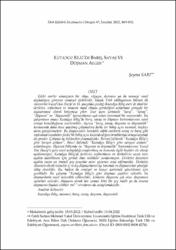| dc.contributor.author | Sarı, Şeyma | |
| dc.date.accessioned | 2023-05-05T09:04:46Z | |
| dc.date.available | 2023-05-05T09:04:46Z | |
| dc.date.issued | 2022 | en_US |
| dc.identifier.citation | SARI, Şeyma. "Kutadgu Bilig’de Barış, Savaş ve Düşman Algısı". Türk Kültürü İncelemeleri Dergisi, 47 (2022):869-892. | en_US |
| dc.identifier.uri | https://tkidergisi.com/kutadgu-biligde-baris-savas-ve-dusman-algisi/kutadgu-biligde-baris-savas-ve-dusman-algisi | |
| dc.identifier.uri | https://hdl.handle.net/11352/4558 | |
| dc.description.abstract | Edebi eserler sanatçının bir olayı, olguyu, durumu ya da nesneyi nasıl
algıladığını gösteren sanatsal ifadelerdir. Klasik Türk edebiyatının bilinen ilk
mesnevisi Yusuf Has Hacip’in 11. yüzyılda yazdığı Kutadgu Bilig eseri de ideal bir
devletin, toplumun ve insanın nasıl olması gerektiğini anlatması yönüyle bir
siyasetname olarak karşımıza çıkar. Eser aynı zamanda “barış”, “savaş”,
“düşman” ve “düşmanlık” kavramlarına ışık tutan kuramsal bir mesnevidir. Bu
çalışmanın amacı Kutadgu Bilig’de barış, savaş ve düşman kavramlarının nasıl
ortaya konulduğunu incelemektir. Ayrıca “barış, savaş, düşman ve düşmanlık”
konusunda daha önce yapılmış çalışmalara farklı bir bakış açısı sunmak, böylece
alanı genişletmektir. Bu düşünceden hareketle edebi eserlerin savaş ve barış gibi
toplumsal meselelere farklı bir bakış açısı kazandırdığını örnekleriyle ortaya koymak
da gerekir. Çalışma üç bölümden oluşmaktadır. Birinci bölümde “Kutadgu Bilig’e
göre barışın anlamı”, ikinci bölümde “Kutadgu Bilig’e göre savaşın anlamı”
anlatılmıştır. Üçüncü bölümde ise “düşman ve düşmanlık” kavramlarının Yusuf
Has Hacip’e göre nasıl anlaşıldığı araştırılmış ve bununla ilgili beyitler ele alınıp
açıklanmıştır. Kutadgu Bilig’de fertlerin, toplumların ve devletlerin uzun süre
ayakta kalabilmesi için gerekli olan nitelikler sıralanmıştır. Devletin düzenini
ayakta tutan en önemli şey insanlar arası güvenin tesis edilmesidir. Devletin
idaresini elinde tutanlar iç ve dış düşmanlarını iyi tanımalı ve düşmanı her yönüyle
takip etmelidir. Bu, halkın da emniyet ve huzur içerisinde yönetilmesi için
gereklidir. Bu çalışma “Kutadgu Bilig’e göre düşman çeşitleri nelerdir, bu
düşmanlarla nasıl mücadele edilmelidir, kimlerin düşmanı çok olur, düşmanın
zararları nelerdir, düşmanı olmak her zaman kötü bir şey midir ya da insana
düşmanın faydası olabilir mi?” sorularını da cevaplamaktadır. | en_US |
| dc.description.abstract | Literary works are artistic expressions that show how the artist perceives an event,
phenomenon, situation or object. Kutadgu Bilig, written in the 11th century by
Yusuf Has Hacip, the first known masnavi of classical Turkish literature, appears
as a policy book in terms of describing how an ideal state, society and human should
be. The work is also a theoretical mesnevi that sheds light on the concepts of "peace",
"war", "enemy" and "hostility". The aim of this study is to examine how the
concepts of peace, war and enemy are introduced in Kutadgu Bilig. In addition, it is
to present a different perspective to the previous studies on "peace, war, enemy and
enmity", thus expanding the field. Based on this idea, it is necessary to demonstrate
with examples that literary works bring a different perspective to social issues such
as war and peace. The study consists of three parts. In the first part, "the meaning
of peace according to Kutadgu Bilig", in the second part "the meaning of war
according to Kutadgu Bilig" is explained. In the third chapter, how the concepts of
"enemy and enmity" were understood according to Yusuf Has Hacip was
investigated and the couplets related to this were discussed and explained. In
Kutadgu Bilig, the qualities necessary for individuals, societies and states to survive
for a long time are listed. The most important thing that keeps the order of the state
alive is the establishment of trust between people. Those who hold the administration
of the state should know their internal and external enemies well and follow the
enemy in every way. This is necessary for the people to be governed in safety and
peace. This study is "According to Kutadgu Bilig, what are the types of enemies,
how to fight these enemies, who has many enemies, what are the harms of the enemy,
is it always a bad thing to be an enemy or can an enemy be beneficial to a person?"
It also answers questions. | en_US |
| dc.language.iso | tur | en_US |
| dc.publisher | KOCAV Kültür Ocağı Vakfı | en_US |
| dc.relation.isversionof | 10.24058/tki.2022.445 | en_US |
| dc.rights | info:eu-repo/semantics/openAccess | en_US |
| dc.subject | Kutadgu Bilig | en_US |
| dc.subject | Mesnevi | en_US |
| dc.subject | Barış | en_US |
| dc.subject | Savaş | en_US |
| dc.subject | Düşman | en_US |
| dc.subject | Düşmanlık | en_US |
| dc.title | Kutadgu Bilig’de Barış, Savaş ve Düşman Algısı | en_US |
| dc.title.alternative | Peace, War and Enemy Perception in Kutadgu Bilig | en_US |
| dc.type | article | en_US |
| dc.relation.journal | Türk Kültürü İncelemeleri Dergisi | en_US |
| dc.contributor.department | FSM Vakıf Üniversitesi, Edebiyat Fakültesi, Türk Dili ve Edebiyatı Bölümü | en_US |
| dc.contributor.authorID | https://orcid.org/0000-0002-8808-4274 | en_US |
| dc.identifier.volume | 47 | en_US |
| dc.identifier.startpage | 869 | en_US |
| dc.identifier.endpage | 892 | en_US |
| dc.relation.publicationcategory | Makale - Uluslararası Hakemli Dergi - Kurum Öğretim Elemanı | en_US |
| dc.contributor.institutionauthor | Sarı, Şeyma | |



















